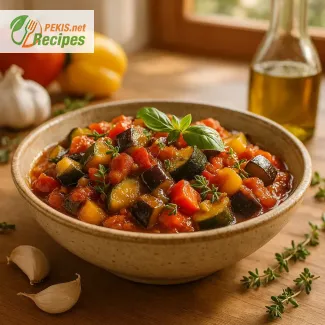
Discover the Delicate Layers of Traditional Lo Bak Go Flavor
Why this classic dim sum radish cake remains a favorite for generations
Lo Bak Go, also known as Chinese Turnip Cake, is one of the most iconic dim sum dishes served in traditional Cantonese teahouses and modern Asian kitchens alike. Its popularity spans generations, transcending cultural boundaries to become a staple at festive gatherings, Lunar New Year celebrations, and everyday dim sum brunches. Made primarily with white radish (daikon), rice flour, and a savory medley of Chinese sausage, dried shrimp, and mushrooms, this dish delivers a perfect harmony of umami, texture, and aroma that is both comforting and deeply satisfying.
Though often labeled a "cake," Lo Bak Go has more in common with a tender, savory pudding. Once steamed and sliced, it's typically pan-fried until the outer edges become golden and crisp, creating a contrast between its creamy interior and its lightly crisp exterior. This dual texture is what makes it so irresistible — and what keeps it at the center of the dim sum table.
What elevates Lo Bak Go beyond a simple radish-based dish is the balance of traditional Cantonese flavors. The pungent aroma of dried shrimp, the sweet fattiness of Chinese lap cheong (sausage), and the earthiness of shiitake mushrooms create a savory mosaic that defines the dish. These ingredients are finely chopped and stir-fried to release their full essence before being folded into the rice flour batter — a batter thickened and enriched by the grated radish’s natural juices.
The methodical preparation of Lo Bak Go reflects deep-rooted culinary traditions. In Chinese cuisine, especially in Cantonese households, food is not just about sustenance but about preserving cultural identity. The process of soaking, slicing, and steaming is more than technical; it's part of the emotional ritual passed down through families. A properly made Lo Bak Go is seen as a mark of respect for heritage and precision in cooking.
Its cultural importance is amplified during the Lunar New Year, when radish cakes are believed to bring prosperity and good luck. In Mandarin, radish is called “cài tóu,” a homophone for “good fortune.” Thus, Lo Bak Go is not only a beloved comfort food but also a symbol of hope and success for the year ahead.
In today's global kitchens, this humble radish cake is being rediscovered by a wider audience. Whether you’re exploring it for the first time or seeking to recreate the flavors of your childhood, Lo Bak Go offers a flavorful journey into classic Cantonese cuisine. The ingredients are now widely accessible, and the preparation process, while requiring patience, is simple enough to master at home. Moreover, the dish can be made in advance, refrigerated, and quickly pan-fried just before serving — making it a practical yet sophisticated addition to modern meals.
The texture is another standout element that resonates with both traditionalists and newcomers. Unlike Western cakes, which rely on sugar and baking agents for volume, Lo Bak Go achieves its body from grated daikon and rice flour, creating a savory structure that’s soft yet cohesive. When cooked correctly, the cake slices should hold their shape while remaining supple, yielding slightly to the bite with a mild peppery finish from the radish.
Additionally, Lo Bak Go serves as a versatile base for culinary creativity. While the classic version includes dried shrimp, lap cheong, and shiitake mushrooms, modern variations may introduce elements like crispy shallots, five-spice powder, or even vegetarian interpretations using umami-rich tofu and seaweed. Despite these adaptations, the soul of the dish — the earthy sweetness of radish and the creaminess of the steamed rice flour — remains intact.
Whether served hot from the pan, alongside a chili soy dipping sauce, or chilled and gently reheated for a midday snack, Lo Bak Go commands attention not by flamboyance but by its subtle depth. It speaks to those who understand that true flavor lies in simplicity, technique, and a respect for ingredients.
A timeless part of Cantonese culinary history, Lo Bak Go brings people together with its delicate yet bold taste — a celebration of flavor and family in every bite.
1. Prepare the daikon radish.
Peel and grate the daikon radish (900 g / 2 pounds) using a coarse grater. In a large non-stick pan or wok, cook the grated radish over medium heat without oil. Allow the radish to release its liquid (about 5–7 minutes). Then add water (250 ml / 1 cup) and simmer gently for another 10 minutes until softened. Do not drain.
2. Prepare savory ingredients.
While the radish is cooking, finely chop the Chinese sausage, rehydrated shrimp, and shiitake mushrooms. In a separate pan, heat a little neutral oil (10 ml / 2 tsp) and sauté the chopped sausage, shrimp, mushrooms, minced garlic (2 cloves), and spring onion (20 g / ⅔ oz) for 2–3 minutes until fragrant. Set aside.
3. Mix the batter.
In a large bowl, combine rice flour (200 g / 1 ⅔ cups) and cornstarch (30 g / ¼ cup). Pour in the cooked daikon along with its liquid. Stir gently to form a smooth, thick batter. Then fold in the sautéed sausage, mushrooms, and shrimp mixture. Season with soy sauce (30 ml / 2 tbsp), salt (4 g / ¾ tsp), white pepper (1 g / ¼ tsp), and sesame oil (10 ml / 2 tsp). Mix until evenly combined.
4. Steam the cake.
Lightly oil a rectangular or square heatproof dish (approx. 20 cm / 8 inch). Pour the mixture into the dish and smooth the top. Place in a steamer and steam over medium-high heat for 60 minutes. Check with a skewer—if it comes out clean, it's done.
5. Cool and slice.
Allow the radish cake to cool completely, then refrigerate for at least 3 hours or overnight. Once firm, slice into rectangular pieces about 1.5 cm (½ inch) thick.
6. Pan-fry before serving.
In a non-stick pan, heat neutral oil (20 ml / 1 ⅓ tbsp) over medium heat. Fry each slice for 2–3 minutes on each side until golden brown and crispy. Serve warm with chili sauce or soy dip.
Elevating Lo Bak Go: Enhancing a Classic with Modern Twists
Creative adjustments and culinary techniques to refine your turnip cake
Lo Bak Go is a cherished part of Cantonese cuisine, celebrated for its comforting textures and savory flavors. Yet even the most traditional dishes can benefit from thoughtful refinement. With small changes in technique or ingredients, you can enhance both the taste and nutritional profile of this timeless radish cake. Whether you're preparing it for festive gatherings or daily meals, improving Lo Bak Go can bring new life to a recipe passed down through generations.
Ingredient upgrades that intensify flavor
A key way to improve this recipe is by adjusting the quality and variety of ingredients. The traditional mix of Chinese sausage, dried shrimp, and shiitake mushrooms is flavorful, but small upgrades can dramatically elevate the taste.
For example, replacing standard dried shrimp with XO sauce (which includes scallops, shrimp, and chili) adds more depth and richness. This substitution boosts the umami factor, making the turnip cake more robust and complex.
If you're a fan of heat, incorporating a small amount of fermented chili bean paste can add a spicy undertone without overpowering the dish. A touch of white miso mixed into the batter brings a subtle sweetness and increased savory intensity.
Another improvement comes from using fresh shiitake mushrooms instead of dried. Though dried mushrooms have a stronger flavor, the texture of fresh mushrooms gives the cake a silkier, more luxurious bite. For those who prefer a vegetarian version, adding chopped king oyster mushrooms or shiitake confit can replicate the meaty chewiness of sausage while retaining the dish’s integrity.
Texture refinements through technique
The hallmark of excellent Lo Bak Go is the contrast between a creamy interior and a crispy outer crust. To better control the final texture, it's essential to cook the grated daikon radish until it’s just softened — not mushy. Overcooking the radish can result in a watery batter, which in turn compromises the cake’s structural integrity.
A small but impactful improvement is allowing the grated radish mixture to cool completely before adding the flours. This preserves the balance between starch and moisture, resulting in a batter that sets better when steamed and fries more evenly later.
You can also experiment with the ratio of rice flour to cornstarch. Increasing cornstarch slightly (by 5–10%) gives a firmer bite and more defined edges when pan-fried, ideal for those who appreciate crisp textures.
Another tip is to steam the batter in smaller, individual portions instead of one large dish. This allows for more surface area when pan-frying, ensuring that each slice gets maximum golden crust with less oil absorption.
Homemade advantages over store-bought versions
Commercially made Lo Bak Go often includes preservatives and flavor enhancers like MSG to boost shelf life and taste. By making it at home, you can avoid additives and control the sodium, sugar, and fat content. Home preparation also allows for fresher ingredients, better-quality oils, and personalized seasoning levels.
Moreover, the act of making Lo Bak Go from scratch becomes a sensory experience — grating fresh daikon, frying the aromatics, and steaming the batter create a connection to the dish that no packaged version can match.
Common mistakes to avoid
One of the most frequent mistakes is using daikon that’s too watery. When grated, daikon releases a large amount of liquid. If this isn’t reduced by simmering, the batter can become too runny, leading to a soggy, collapsing cake.
Another issue is under-seasoning. Since the rice flour base is neutral in taste, it’s important to build flavor through sautéed fillings and seasoning the batter generously. Don’t hesitate to taste the sautéed mix before adding it to the batter.
A common textural misstep is overmixing the batter after adding fillings. Stir gently to avoid breaking down the radish fibers or turning the batter gluey.
Finally, rushing the pan-frying step will prevent proper caramelization. Always preheat the pan and give the slices space to brown evenly.
Health-conscious adjustments and modern alternatives
For a healthier version, substitute Chinese sausage with lean turkey sausage or plant-based alternatives. Reduce the amount of cooking oil used in pan-frying by using a non-stick ceramic skillet or finishing the slices in an oven broiler to achieve a similar crispy texture.
You can also reduce sodium by using low-sodium soy sauce or coconut aminos, and skip the dried shrimp in favor of roasted sesame seeds or miso paste for umami richness without shellfish.
Those sensitive to gluten should ensure that the soy sauce is gluten-free (tamari is a great alternative). You may also replace cornstarch with arrowroot flour, which behaves similarly and is suitable for most allergen-sensitive diets.
For fiber enhancement, adding a handful of grated carrots or zucchini (well-drained) can lighten the texture while adding color and nutrients. A teaspoon of ground flaxseed can also subtly boost omega-3 content without affecting the flavor.
Making Lo Bak Go your own
Once you've mastered the base recipe, Lo Bak Go becomes a canvas for creativity. From adding crispy shallots, chili oil drizzles, or scallion gremolata, you can make the dish feel new every time while keeping its traditional essence intact.
These thoughtful tweaks not only improve taste and texture but also ensure that this dim sum classic remains relevant and rewarding in any modern kitchen. With each adjustment, you're not just cooking — you're crafting a personalized culinary experience rooted in culture and elevated by innovation.
Allergens present in the recipe:
- Shellfish (dried shrimp)
- Soy (soy sauce)
- Gluten (soy sauce may contain gluten depending on brand)
Suggestions to replace allergens and gluten:
- Replace dried shrimp with finely chopped shiitake mushrooms or smoked tofu for a shellfish-free version.
- Use gluten-free soy sauce or tamari to make the recipe gluten-free.
- Vegetarian version: omit sausage and shrimp and increase mushrooms and scallions.
- Vitamin C: 20 mg – supports immune system and collagen production
- Vitamin B6: 0.2 mg – helps with metabolism and brain health
- Potassium: 480 mg – essential for heart and muscle function
- Calcium: 45 mg – supports bone strength
- Iron: 1.4 mg – important for oxygen transport in the blood
- Magnesium: 28 mg – contributes to muscle and nerve function
- Folate: 30 µg – supports cell division and growth
- Polyphenols: 60 mg – protect cells from oxidative stress
- Allicin (from garlic): trace – contributes to heart health and immunity
- Beta-glucans (from mushrooms): 90 mg – supports immune function
- Anthocyanins (trace from sausage flavorings): minimal – may help reduce inflammation





